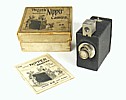Little Nipper
W. Butcher & Sons
| Model / Variant: | Little Nipper No 1 |
| Plate / Film Size: | 4.5 cm x 6 cm glass plates (6) or sheet film (12) |
| Lens: | Meniscus |
| Shutter: | Spring powered sector shutter (see description) |
| Movements: | None |
| Date of this Example: | c1902 |
| Serial Number: | None |
| Availability: |
|
| Inventory Number: | 575 |
|
Photos copyright © 2012 David Purcell. Do not use without permission. |
Description
This is the original model of the "Little Nipper" camera, which is of a simple falling plate design. It was introduced in 1901. The camera takes six 4.5 x 6 cm plates (the No 1 size) in individual metal sheaths or, according to the instructions, twelve sheet films in sheaths. One of the pictures above shows two of the sheaths from the set that show the alternating notch pattern on the top edge that allowed the plate changer lever on the top of the camera to release alternate exposed sheaths into the base of the camera.
The camera itself was also marketed by Huttig as the Gnom, which then became the Aviso (c1907, with slight modifications apparently) that in turn was continued under the same name by Ica after the merger. It therefore seems likely that the camera was made for Butcher by Huttig, in common with a number of other cameras that Butcher marketed in the years before the First World War.
The camera is of metal construction, covered in black leatherette cloth. This example is in good condition, although the leather covering has loosened from the underlying metal in places. It retains it clip on finder (an original part of the camera kit, not an accessory), its original instructions and its box. The box shows that the camera was originally sold for 4/6, which is apparently the price advertised in the 1902 BJPA. The No 2 size took 3½" x 2½" plates (and is not a size I have ever seen).
The camera is equipped with a lens cap, strung to the camera. This is important to its operation as the lens has to be capped when setting the shutter.
The camera came in its original box, marked The Little "Nipper" Camera, Price 4/6 with Finder. The box is in good condition, but rather grubby. It has some corner damage.
The camera also retains its original instruction booklet, which reproduces the same picture on the cover as shown on the lid of the box. Note the use of little imp type figures in the drawing (equivalent to the contemporary Brownie characters used by Kodak). The instructions show an advert for the full developing and printing output, price 3/-.
Notes
This model was superseded about 1922 by a more conventional box style of camera of the same name, made of cardboard and taking a single plate (or sheet film) in a special holder rather than being a falling plate pattern. The later Little Nipper camera is more common.

![[ ]](../../images/unchecked.png)
![[x]](../../images/checked.png)








